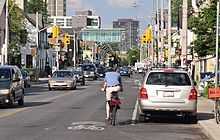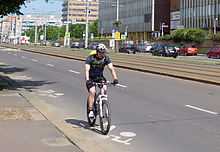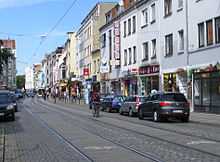Shared lane marking

A shared-lane marking or sharrow[1] is a street marking installed at locations in Australia, Canada, and the United States. This marking is placed in the center of a travel lane to indicate that a cyclist may use the full lane.
According to the US Manual on Uniform Traffic Control Devices, shared-lane markings are used to:
- Assist cyclists with lateral positioning in a shared lane with on-street parallel parking in order to reduce the chance of a bicyclist impacting the open door of a parked vehicle;
- Assist cyclists with lateral positioning in lanes that are too narrow for a motor vehicle and a bicycle to travel side by side within the same traffic lane;
- Alert motorists of the lateral location bicyclists are likely to occupy within the traveled way;
- Encourage safe passing of bicyclists by motorists; and
- Reduce the incidence of wrong-way bicycling.[2]
History
These markings are used in the USA, Australia and other countries. In US usage, the wide shape of the arrow, combined with the bike symbol, gave rise to unofficial names such as "bike in a house" or "sharrow". In the UK roughly the same function is served by a bicycle symbol without arrows. However, this tends to be used more as an indication of a formal cycle route rather than as an encouragement to share the road.
The original "bike in a house" or "man jumping barrels at home" marking was developed by James Mackay and included in the 1993 Denver Bicycle Master Plan.[3] While Mackay had considered a "connect the dots" pavement markings approach for bicycle route definition and cyclist lane positioning reinforcement (during his time as the Bicycle Facilities Engineer for the North Carolina Department of Transportation), the City of Denver's unwillingness to commit to bike lane markings meant that shared lane markings were the only pavement marking treatment for bicyclists that the City would implement. The hollow arrow surrounding the cyclist was intended to reinforce the correct direction of travel for bicyclists (who were frequently observed riding the wrong way, against traffic, in Denver).[4]
In 2004, the city of San Francisco, California began experimenting with the shared lane marking,[5] and developed a revised symbol consisting of a bicycle symbol with two chevron markings above the bicycle. In the process, the name sharrow was coined by Oliver Gajda, of the City and County of San Francisco Bicycle Program, and is a portmanteau of share and arrow.[6][lower-alpha 1]
In a 2009 paper,[8] Northeastern University researcher Peter G. Furth proposed the "Bicycle Priority Lane", which combines sharrows with dotted lines inside the usual lane markings. This marks a five-foot-wide zone in the center of the lane which bicyclists are encouraged to use. The city of Boston, Massachusetts began experimenting with these markings in 2013.[9]
Effectiveness
.jpg)
Behavioral studies have shown that streets with shared lane arrows increase separation between motor vehicles and cyclists, encourage cyclists to ride outside of the door zone, and may reduce wrong way cycling and sidewalk cycling, which are associated with increased crash risk.[10][11]
However, another study based on hospital records shows no statistically significant reduction in injuries, and possibly a small increase.[12]
Usage
North America
Based on the San Francisco experimental data, in August 2004 the California Traffic Control Devices Committee (CTCDC) approved the use of this marking in California.[13] In the 2009 edition of the Manual on Uniform Traffic Control Devices, shared lane markings were approved for general use.[14] The city of Seattle, Washington included extensive use of shared lane markings in its Bicycle Master Plan of early 2007.[15] The concept has since been implemented by cities throughout the United States.[16]
Shared lane marking has been adopted in Canada, being used in localities ranging from Montreal[17] to Vancouver.[18]
Worldwide


For several years, the traffic rules of France have allowed shared lanes, there called voies partagées, in addition to two types of dedicated bike lanes. One of those is obligatory, the other is one not obligatory, but also reserved for bicycles. All have the same pictograms on the street surface, but are distinguished by roadside signs.
In the Czech Republic, a series of sharrows on shared lanes are called Cyklopiktokoridor which translates as "cycle pictogram corridors". For cycle lanes with marked limits, a strict type and a soft type exist (as in France), and are distinguished by different pictograms.
The concept of shared lane markings has also appeared in Spain [19] and New Zealand. [20]
In Germany, the concept is not yet established officially, but some local authorities use simple bike logos for the same purpose, without having a specific term for them.
See also
Notes
References
- ↑ 23rd Streetscape Project, City of Richmond website, access date December 28, 2008
- ↑ Manual on Uniform Traffic Control Devices, Part 9, Traffic Control for Bicycle Facilities, 2009,
- ↑ 1993 Denver, Colorado Bicycle Plan
- ↑ e-mail from James Mackay to John S. Allen, May 21, 2011
- ↑ 5.0 5.1 "San Francisco's Shared Lane Pavement Markings: Improving Bicycle Safety", February 2004". Archived from the original on August 2010.
- ↑ San Francisco Bay Bikers blog entry on San Francisco Chronicle site
- ↑ San Francisco Bicycle Advisory Committee (BAC): Regular Meeting Minutes, Wednesday, July 21, 2004
- ↑ Peter G. Furth (2009-01-08). "Bicycle Priority Lanes: A Proposal for Marking Shared Lanes". Retrieved 2013-12-01. Alternate URL
- ↑ Martine Powers (2013-11-20). "Starts and Stops: New ‘sharrows on steroids’ debut on Allston’s Brighton Ave.". Boston Globe.
- ↑ "Evaluation of Shared Lane Markings". Federal Highway Administration. October 2010. Retrieved Feb 27, 2013.
- ↑ Alta Planning and Design (February 2004). "San Francisco's Shared Lane Pavement Markings: Improving Bicycle Safety". San Francisco Department of Parking & Traffic. Retrieved Feb 27, 2013.
- ↑ Harris MA, Reynolds CC, Winters M et al. (October 2013). "Comparing the effects of infrastructure on bicycling injury at intersections and non-intersections using a case-crossover design". Injury Prevention 19 (5): 303–10. doi:10.1136/injuryprev-2012-040561. PMC 3786647. PMID 23411678.
- ↑ CTCDC Minutes, August 12, 2004
- ↑ "Manual on Uniform Traffic Control Devices, 2009 Edition Chapter 9C. Markings". FHWA - US DOT. Section 9C.07: US DOT - FHA. Retrieved 29 December 2014.
- ↑ "Two more weeks to comment on city bike plan", Seattle Post-Intelligencer, May 4, 2007
- ↑ ATSSA webpage on MUTCD experimentation & interpretation letters
- ↑ Christopher deWolf. "Follow the sharrows." Spacing Montreal, August 29, 2007
- ↑ "Sharrows, shared use markings"
- ↑ "Red de carriles bici"
- ↑
External links
| Look up sharrow in Wiktionary, the free dictionary. |
| Wikimedia Commons has media related to Sharrows. |
- Manual on Uniform Traffic Control Devices (MUTCD), 2009 Edition: Chapter 9C. Markings, see last section!
- "Four Solid Uses for Sharrows"
- NCUTCD webpage on shared-lane marking
- FAQ on shared lane markings created by Bike Pittsburgh and the Pittsburgh Dept. of City Planning
- Thunder Bay (Ontario): Informations for motorists and cylists on shared lanes and bike lanes
